Well, the news is out -- the Apple iPad tablet has been revealed. There's a lot of instant reaction, but you'll have to wait some 3 months to actually buy the Wi-Fi version, and another month after that for the Wi-Fi + 3G version with AT&T cellular Internet data service.
As usual, the keynote presentation by Steve Jobs was masterly, and the introductory video carries on the theme of "Our most advanced technology in a magical and revolutionary device at an unbelievable price." Yeesh!
It's A Big iPod touch
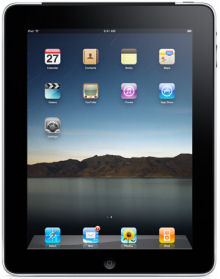 The iPad a beautiful device that seems to be quite smooth and responsive, with a 9.7 inch 1024 x 768 multi-touch display (vs. 3.5 inch 480 x 320 for the iPhone), though there is a rather wide bezel around the display.
The iPad a beautiful device that seems to be quite smooth and responsive, with a 9.7 inch 1024 x 768 multi-touch display (vs. 3.5 inch 480 x 320 for the iPhone), though there is a rather wide bezel around the display.
The size is a bit smaller than a pad of paper, at 7 1/2 x 9 1/2 x 1/2 inches, and 1 1/2 pounds. That's about the thickness of the iPhone, although a bit thicker then the iPod touch (at 1/3 inch).
The iPad is based on the iPhone software platform, and not a notebook platform like Mac OS. Jobs described it as "much more intimate than a laptop," so, for example, you still swipe the screen to unlock it.
And the iPad runs all the 140,000-some existing iPhone apps, in a small window at the center of the screen or pixel-doubled to fill the display. Apple also says you can sync your existing iPhone apps to the iPad, so you don’t have to buy them again.
It Runs Full-Screen Apps
Meanwhile, Apple has released developer tools to rework applications for the larger screen, and the iPad comes with 12 updated and new Apple apps that take advantage of the larger surface to view and interact with the multi-touch display. For example, the apps now use drop-down menus and pop-up context menus that don't really work on smaller displays. The resulting apps look more like laptop applications, from iPod music and Video browser / players, to Mail and Calendar and Contacts, to iTunes and App Stores -- plus the new iBookstore.
And Apple has developed versions of its iWork suite for the iPad - the Pages word processor, Numbers spreadsheet, and Keynote presentations, each for $9.99.
For text input, the iPad displays an almost-full-screen keyboard, although you'll need to work on finding a comfortable position to type comfortably with both hands, for example while resting the tablet in your lap.
The iPad line starts with a 16 GB model with Wi-Fi for $500. Add another $100 to double the memory, to 32 GB for $600, and then 64 GB for $700. The W-Fi + 3G models are then another $130 more, 16 GB for $630, 32 GB for $730, and the top of the line 64 GB with 3G for $830. AT&T 3G service will be $14.99 a month for 250 MB, or unlimited for $29.99 -- with no contract required.
It's Not a Netbook
Following the bigger iPod touch theme, the iPad is missing the same features that were stripped out of the iPhone to differentiate the touch, including the phone, camera, and GPS (except there's assisted GPS with the 3G model).
So the real question for the iPad is whether it's the right device to compete with all those $200 netbooks that flew off the shelves over the holidays (even stacked as impulse items in our local grocery stores).
Jobs was clear about his position -- "Netbooks aren’t better at anything -- They’re just like cheap laptops." And yes, what netbooks are better at is being cheap and highly portable.
But netbooks also give you a lot of options that the iPad does not, including a removable battery for long trips, and a memory card slot and USB connector to back up and exchange your work with others. And they have video connectors to display directly from your device, though VGA and even HDMI for HD video. With the iPad, these will require separate adapters for the Apple dock connector.
The iPad also appears to not have any new support for multitasking, which is interesting as Apple runs TV commercials promoting the iPhone's ability to run other apps as you talk on the phone. But you apparently still can't have apps running in the background checking for new information as you work or move around, and then notify you when needed. Yes, netbooks running Windows are slower than full-featured laptops as you switch between programs and run computer-intensive processing in the background, but at least you do have the option to work this way.
So the iPad is perhaps more comparable to the "quick-start" modes in some netbooks with products like Phoenix HyperSpace that lets you "use your PC like a smartphone." These are typically based on a slimmed down Linux OS that starts up instantly into a reduced environment for performing a wide range of common operations including playing media, editing documents, checking email, Web browsing (and playing videos), and even Internet phone.
When you limit the capabilities like this, netbooks can run quite well. Then you can switch to full Windows as needed for specific tasks, and accept the limitations of the underpowered platform if you choose to multi-task between more intensive processing.
It's A Merchandizing Channel
So it seems that the iPad is not a "netbook killer," at least for those who need the ability for a netbook to step up to heavier work. But the iPad certainly should be interesting to those who were looking at netbooks for only doing more basic viewing, editing, and browsing.
Plus, the familiarity of the iPhone interface and depth of the Apple's merchandising (iTunes, App, and now iBook store) are much more compelling than a generic netbook with a fast-start interface.
Perhaps the real bottom line of the iPod presentation was that Apple has seen over 12 billion downloads from its now three stores, and has assembled files of 125 million accounts with credit cards that can purchase from the stores. That's an amazingly powerful channel, and strong lock-in to its growing family of platforms.
See my Apple iPod / iPhone Gallery for details on the iPad, iPhone, and iPod products and product line history.
 Find the Apple iPad on Amazon.com
Find the Apple iPad on Amazon.com
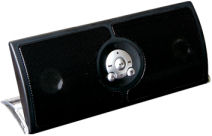
![]() Find the Miccus BluBridge Mobile Speaker and
Find the Miccus BluBridge Mobile Speaker and

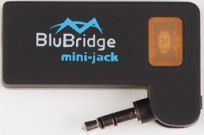
 The 2010 edition of the
The 2010 edition of the 


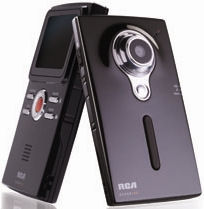 For example, the RCA EZ209HD Small Wonder 720p HD Digital Camcorder for $129 / $89 street shoots up to 720p HD video in a slim design (~ 4.3 x 2.5 x 0.9 inches, 3 ounces) -- amazingly thin with a bump-out lens.
For example, the RCA EZ209HD Small Wonder 720p HD Digital Camcorder for $129 / $89 street shoots up to 720p HD video in a slim design (~ 4.3 x 2.5 x 0.9 inches, 3 ounces) -- amazingly thin with a bump-out lens. The
The 
 Now that CES is done, we can look forward to
Now that CES is done, we can look forward to 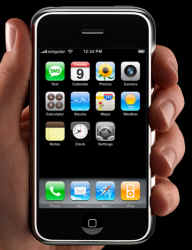 AT&T and Verizon Wireless have announced new pricing plans for unlimited voice and data service. After all, we want mobile access to email and Web, and the carriers are happy to encourage more use of their networks for such data services.
AT&T and Verizon Wireless have announced new pricing plans for unlimited voice and data service. After all, we want mobile access to email and Web, and the carriers are happy to encourage more use of their networks for such data services.  But E-ink is not just for digital paper for electronic books. The
But E-ink is not just for digital paper for electronic books. The 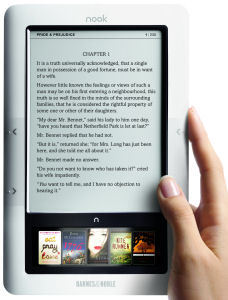 - The
- The  - The
- The 
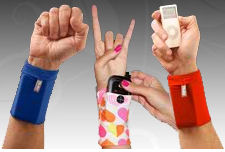 But it's the ingenuity and persistence of these individuals that's really fun to see in action. For example, South Mill Design, a small company based near Princeton, N.J., has developed a wrist pouch called
But it's the ingenuity and persistence of these individuals that's really fun to see in action. For example, South Mill Design, a small company based near Princeton, N.J., has developed a wrist pouch called 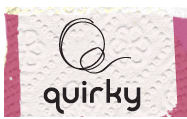 That's the idea behind
That's the idea behind  For example, the DigiDudes is a portable camera tripod with retractable legs that collapses and then screws into a bell-like holder (decorated as funky dude), with a keychain to hang on your bag or belt ($24).
For example, the DigiDudes is a portable camera tripod with retractable legs that collapses and then screws into a bell-like holder (decorated as funky dude), with a keychain to hang on your bag or belt ($24).  The
The  The iPad a beautiful device that seems to be quite smooth and responsive, with a 9.7 inch 1024 x 768 multi-touch display (vs. 3.5 inch 480 x 320 for the iPhone), though there is a rather wide bezel around the display.
The iPad a beautiful device that seems to be quite smooth and responsive, with a 9.7 inch 1024 x 768 multi-touch display (vs. 3.5 inch 480 x 320 for the iPhone), though there is a rather wide bezel around the display.  Or, you can download the
Or, you can download the